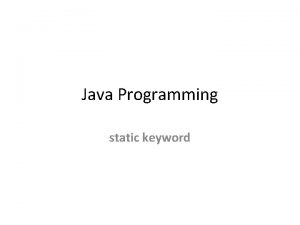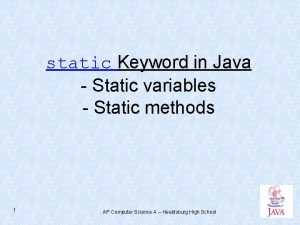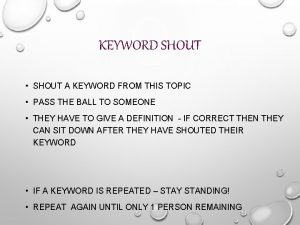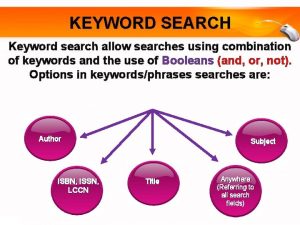Static Keyword What is static The static keyword








- Slides: 8

Static Keyword

What is static • The static keyword is used when a member variable of a class has to be shared between all the instances of the class. • All static variables and methods belong to the class and not to any instance of the class

When can we access static variable • When a class is loaded by the virtual machine all the static variables and methods are available for use. • Hence we don’t need to create any instance of the class for using the static variables or methods. • Variables which don’t have static keyword in the definition are implicitly non static.

Example Class static. Demo{ public static int a = 100; // All instances of static. Demo have this variable as a common ` variable public int b =2 ; public static show. A(){ System. out. println(“A is “+a); } } Class exec. Class{ public static void main(String args[]){ static. Demo. a = 35; // when we use the class name, the class is loaded, direct access to a without any instance static. Demo. b=22; // ERROR this is not valid for non static variable static. Demo demo = new static. Demo(); demo. b = 200; // valid to set a value for a non static variable after creating an instance. static. Demo. show. A(); //prints 35 } }

Static and Non-static • We can access static variables without creating an instance of the class • As they are already available at class loading time, we can use them in any of our non static methods. • We cannot use non static methods and variables without creating an instance of the class as they are bound to the instance of the class. • They are initialized by the constructor when we create the object using new operator.

How it works Basic Steps of how objects are created 1. Class is loaded by JVM 2. Static variable and methods are loaded and initialized and available for use 3. Constructor is called to instantiate the non static variables 4. Non static variables and methods are now available • As all the non static variable are available only after the constructor is called, there is a restriction on using non static variable in static methods.

Why do we need this • Static methods are identified to be mostly used when we are writing any utility methods. • We can also use static variables when sharing data. • When sharing data do keep in mind about multithreading can cause inconsistency in the value. (synchronize the variable)

Further Reading • http: //docs. oracle. com/javase/tutorial/java/ja va. OO/classvars. html















